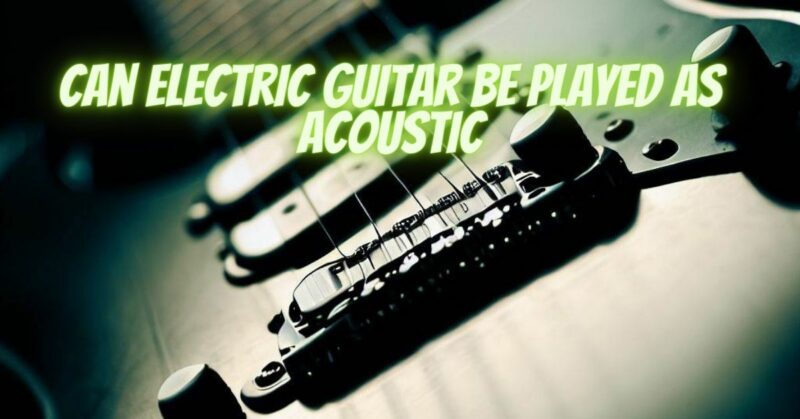Electric guitars are typically associated with powerful, amplified tones. However, many guitarists wonder if an electric guitar can be played in an acoustic style, producing a sound similar to that of an acoustic guitar. In this article, we will delve into the versatility of electric guitars and discuss their potential for creating acoustic-like tones.
- Unique Tonal Characteristics: Electric guitars have distinct tonal characteristics that are different from acoustic guitars. The electric guitar’s sound is shaped by factors such as pickups, solid-body construction, and amplification. These elements contribute to the electric guitar’s signature sound, known for its sustain, harmonic richness, and the ability to shape the tone through various effects.
- Playing Unplugged: While an electric guitar cannot fully replicate the sound of an acoustic guitar, it can be played unplugged to produce a softer, more subdued tone. When played without amplification, an electric guitar can resemble the sound of an acoustic guitar to some extent, but it will lack the natural resonance and projection inherent to acoustic instruments.
- Adjusting Playing Technique: To achieve a more acoustic-like sound on an electric guitar, adjustments to playing technique can be made. Lightening the attack and using fingerpicking or strumming techniques commonly associated with acoustic guitar playing can help produce a softer, more mellow sound. This adaptation allows guitarists to explore a different sonic palette while still utilizing the electric guitar’s unique qualities.
- Tone Controls and Effects: Electric guitars often feature tone controls that allow players to shape the sound. By dialing down the tone controls, particularly on the neck pickup, and reducing the use of effects, guitarists can achieve a warmer, more organic tone reminiscent of acoustic guitars. Experimenting with different settings can yield varying results, enabling players to find a balance that emulates an acoustic-like sound.
- Acoustic Simulation Effects: To enhance the acoustic-like qualities of an electric guitar, some guitarists utilize effects pedals or amp simulations specifically designed to emulate the sound of an acoustic guitar. These effects can provide enhancements such as body resonance simulation, simulated microphone placement, or EQ adjustments to approximate the acoustic guitar’s sonic characteristics.
- Hybrid Guitars: Hybrid guitars, also known as acoustic-electric guitars, offer a combination of acoustic and electric elements. These guitars feature a hollow or semi-hollow body construction, allowing for natural acoustic resonance, while also incorporating pickups for amplification. Hybrid guitars provide a more authentic acoustic sound when amplified, blending the tonal qualities of both acoustic and electric guitars.
Conclusion:
While an electric guitar cannot fully replicate the sound and tonal qualities of an acoustic guitar, it can be played in an acoustic style to produce a softer, mellow tone. Adjusting playing technique, utilizing tone controls, and exploring effects can help create an acoustic-like sound on an electric guitar. For a more authentic acoustic experience, hybrid guitars offer a combination of acoustic resonance and amplification capabilities. The versatility of electric guitars allows guitarists to explore a range of tones and styles, making them a valuable tool for creating a diverse musical palette.


